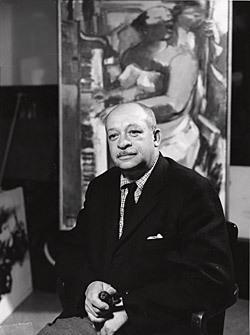
Charles Henry Alston (1907–1977), Walking, 1958, oil on canvas, 48 x 64 in., © Charles Alston Estate Collection of National Museum of African American History and Culture, Gift of Sydney Smith Gordon, TR2007-4
Student Questions
1. Note the painting's title. How does Charles Henry Alston illustrate walking?
2. What aspects of the painting suggest movement?
3. Why do you think Alston blurred the details in most of the faces?
About This Artwork
In 1958, Charles Alston created Walking, a vibrant painting that depicts a group of walking women composed of sturdy shapes and outlined by vivid slabs of color. Inspired by the Montgomery bus boycott and the determined actions of the mostly unrecognized women who orchestrated it, Alston employed abstract techniques to evoke the resolute energy that sustained the protest for more than a year in the mid-1950s. By constructing the cluster of women on the left out of broad, vertical bands of color, and by contrasting them with the women on the right, whom he painted with upward turning faces and with angular limbs that suggestion motion, Alston created a striking left-to-right transition that conveys a sense of spontaneous but purposeful movement. Alston recalled, "It was a very definite walk—not going back, no hesitation"— a mood he captured with his bold handling of paint and carefully arranged scene.
From late 1955 through 1956, a successful and hard fought boycott of segregated buses in Montgomery, Alabama, inspired people across the United States and around the world. Though these events brought international fame to two prominent civil rights figures—a young reverend named Martin Luther King Jr. and a seamstress and activist named Rosa Parks—the boycott also represented a triumph of local grassroots activism on a massive scale. Organized by black women’s political groups and facilitated through churches, the boycott mobilized thousands of black workers to avoid using segregated city buses to protest the unequal and demeaning practices of segregation. Years later, the figures of King and Parks loom large, but the boycotters themselves—and their exhausting, and at times humiliating, effort of walking to work day after day—are often overlooked.
By focusing his painting on unidentified women and, at center, two children, Alston presented an inclusive rendition of the figures that formed the backbone of the Civil Rights movement. His use of abstraction universalizes the notion of protest, inviting it any and everywhere. Painted in 1958, before the 1965 civil rights marches in Alabama, this canvas seems prescient. "The idea of a march was growing," Alston recalled. "It was in the air … and this painting just came. I called it Walking on purpose." Reimagining the daily drudgery of traveling by foot as a determined march, Alston at once celebrates the actions of the protesters of segregated Montgomery and elevates the mundane act of walking to something monumental and heroic.
About This Artist
Charles Henry Alston (born Charlotte, NC 1907–died New York City 1977)
Painter and sculptor Charles Alston was born in Charlotte, North Carolina, and moved to New York City as a child, where he attended high school and college, earning his MFA at Columbia University. Alston painted during the Harlem Renaissance, experimenting with African motifs as well as depicting the lives of ordinary black Americans. During the Great Depression, he was one of only a few African American supervisors for the Works Progress Administration (WPA), and he taught many young artists, including Jacob Lawrence, at the WPA-sponsored Harlem Community Art Center. Later, Alston helped found Spiral, a group of New York African American artists who met regularly during the 1960s to discuss the relationship of their art to struggles for racial justice. Claiming the influence of the Civil Rights movement on his work, Alston stated, “the basically important thing is making a good picture … out of what your experience has been, and mine has been the experience of a black man in a fairly racist country.” Alston was one of the first black artists to have work exhibited in the Museum of Modern Art. His artwork can also be found in the Metropolitan Museum of Art, the Whitney Museum of American Art, the National Museum of African American History and Culture, the Detroit Institute of Art, Butler Art Institute, and Clark Atlanta University Art Galleries.
Related Material

Rosa Parks’s dress, about 1955. National Museum of African American History and Culture, Gift of the Black Fashion Museum founded by Lois K. Alexander-Lane
Rosa Parks, a forty-two-year-old seamstress and longtime civil rights activist, was carrying this dress—one she was then tailoring—when she made her fateful decision that sparked the Montgomery bus boycott. Parks’s refusal to give up her bus seat to a white man was not made in the spur of the moment. In fact, it was a tactical decision made as part of a strategy to advance equal rights through coordinated acts of civil disobedience.

Martin Luther King and The Montgomery Story, comic book. Ed King Collection, Archives Center, National Museum of American History, Smithsonian Institution
Created by the Fellowship of Reconciliation, an interracial Christian civil rights organization, this sixteen-page comic book, developed to appeal to youths, was distributed throughout the South following the Montgomery bus boycott. A Spanish language version was widely distributed throughout Central and South America, demonstrating the international influence of the African American Civil Rights movement.

Segregation sign, Nashville City Transit, about 1950. National Museum of African American History and Culture
City buses were segregated throughout the South in the early and mid-twentieth century. In 1960, Nashville students, in coordination with the local chapter of the NAACP, protested to force the integration of public transportation. This sign from a segregation-era Nashville bus reads "This part of bus for colored race." Residue on the sign shows that it was covered up by another label after integration until the bus went out of service.















